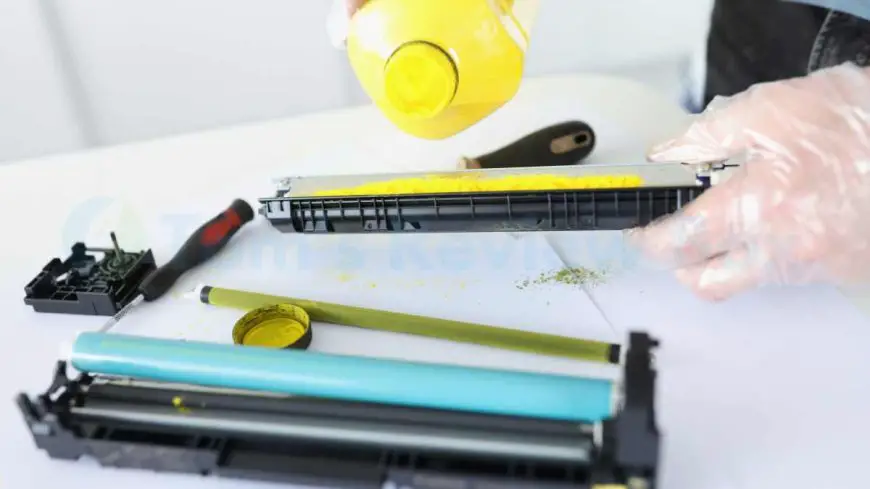How to Install Printer on Print Server: Step-by-Step Guide
Learn the step-by-step process of installing a printer on a print server. Our comprehensive guide ensures a smooth setup process.

Are you struggling to set up your printer on a print server? Installing a printer on a print server can streamline your printing process and enhance efficiency. In this guide, we will walk you through the step-by-step process of how to install a printer on a print server effortlessly.
Key Takeaways
-
Understand the role of print servers in managing printers efficiently within a network.
-
Prepare for a successful printer installation by gathering necessary information and ensuring compatibility.
-
Add a printer on Windows 10 by accessing the Control Panel and following the guided setup process.
-
Utilize the directory for adding printers to simplify the installation process and streamline printer management.
-
Request access to printers from the network administrator to ensure proper permissions for installation.
-
Install network printers on Windows by selecting the network printer option and following the prompts for setup.
Understanding Print Servers
Basics and Benefits
Network printers operate in a shared environment, offering convenience and accessibility from multiple devices. Installing printers centrally on a print server can streamline printing processes in organizations.
-
Centralized printer installation simplifies management.
-
Network printers enhance collaboration and productivity.
-
Reduced maintenance costs with centralized printer management.
Network Printer Concept
Local printers are connected to individual computers, while network printers are accessible from any device connected to the network. Accessing network printers from multiple devices enhances flexibility and efficiency.
-
Network printers facilitate easy sharing among users.
-
Local printers limit accessibility to one specific device.
-
Network printers promote collaboration and resource sharing.
Print Server Role
Print servers play a crucial role in managing network printers by facilitating efficient printing across the network. They handle print jobs, manage printer queues, and ensure seamless communication between devices.
-
Print servers optimize printing resources and improve efficiency.
-
Centralized management of print jobs ensures faster processing times.
-
Print servers enhance security by regulating access to printers.
Preparing for Installation
Checking Requirements
Before proceeding with the installation of a printer on a print server, identify the essential requirements. Ensure that your system has the necessary components like drivers and network connectivity. Check for compatibility issues to prevent any hindrances during the installation process.
Network Configuration
Understanding the significance of proper network configuration is crucial for successful printer installation. Configure network settings accurately to establish seamless connectivity between the printer and the server. Different network configurations can impact how well the printer functions within the network environment.
Access Permissions
Access permissions are pivotal when it comes to adding printers to a print server. Understand how having the right permissions is essential for a smooth printer installation process. Explore how access permissions directly influence and determine the printing experience for users.
Adding Printer on Windows 10
Accessing Control Panel
To access the Control Panel, navigate to the Start menu and type "Control Panel" in the search bar. Click on the Control Panel app to open it. Within the Control Panel, locate the "Devices and Printers" option to manage printer settings effectively. Explore various printer management options such as adding new printers, setting a default printer, or troubleshooting printing issues.
Printer Discovery
Understanding how to discover available printers on the network is crucial for adding a printer to a print server. To find printers on the network, go to the Control Panel and select "Devices and Printers." Click on "Add a printer" and choose between a local or network printer. By selecting a network printer, you can browse through available printers connected to the network and add them to your print server seamlessly.
-
List of methods for identifying printers within the network environment:
-
Check with your IT department for a list of networked printers.
-
Utilize network scanning tools to detect all devices connected to the network.
-
Installation Steps
Follow these step-by-step instructions for installing a printer on a print server running Windows 10:
-
Open the Control Panel and click on "Devices and Printers."
-
Select "Add a printer" and choose between local or network printer installation.
-
Choose the desired printer from the list of available printers on your network.
-
Follow the prompts to install necessary drivers and configure printer settings.
-
Once installed, test print a document to ensure proper functionality.
-
Key installation steps include:
-
Selecting the correct printer model during installation.
-
Verifying that the printer is connected to the same network as the print server.
-
Using Directory for Printer Addition
Directory Services
Directory services play a crucial role in facilitating printer installation on a print server. They act as a centralized database that simplifies the search for network printers by providing essential information about available printers. By utilizing directory services, users can easily locate and connect to printers across the network. This streamlined process enhances efficiency and reduces the time spent on manual searches.
Effective utilization of directory services simplifies the search for specific printers based on various criteria such as name, location, or type. Users can input their desired specifications into the directory system, which then presents a list of matching printers available on the network. This targeted approach enables quick access to the required printers without unnecessary delays, ensuring a seamless printing experience for users.
The benefits of using directory services for printer management are manifold. These services offer centralized control and monitoring capabilities, allowing administrators to oversee all connected printers from a single interface. Directory services enhance security by regulating access to printers based on user permissions. By leveraging directory services, organizations can streamline their printing infrastructure and optimize resource allocation effectively.
Searching Printers
To search for printers efficiently on the network, users can employ various methods to pinpoint specific devices. By utilizing advanced search techniques within the directory system, individuals can quickly locate printers that meet their requirements. Whether searching by printer name, location, or other attributes, users can narrow down their options and identify the most suitable devices for installation.
When searching for printers on the network, it is essential to utilize filtering options provided by the directory service. These filters enable users to refine their search based on specific parameters such as printer type or availability status. By leveraging these search functionalities effectively, individuals can expedite the process of locating and connecting to network printers with ease.
Exploring different search techniques within the directory system allows users to customize their search queries and retrieve accurate results promptly. By experimenting with various search parameters and refining their search strategies, individuals can enhance their ability to find and add printers efficiently to the print server. This proactive approach streamlines printer installation processes and optimizes workflow productivity.
Selection and Adding
The process of selecting and adding printers to the print server involves carefully choosing from the available options presented within the directory system. Users need to assess factors such as printer compatibility, functionality, and proximity before making their selection. Once a suitable printer has been identified, individuals can proceed with adding it to the network by following simple steps outlined in the system.
Requesting Printer Access
Identifying Admin
Understanding the administrator's role in managing printers is crucial for gaining access to printer settings. Contact the admin for assistance during printer installation.
Sending Request
Initiate a formal printer access request process with the administrator to gain necessary permissions. Submitting a formal request is essential.
Approval Process
Administrators review and approve printer access requests through a specific approval process. Expect a timeline for receiving approval post-request submission.
Installing Network Printer on Windows
Printer Setup Wizard
When setting up your printer, follow the instructions from the printer setup wizard. The wizard will guide you through configuring printer settings effortlessly. Explore the features of the setup wizard for a smooth installation process.
Choosing Network Printer
To select the right network printer, understand the criteria involved in making your choice. Evaluate different printers based on your specific requirements to make an informed decision. Consider factors like printing speed and connectivity options when selecting a network printer for your workspace.
Driver Installation
Installing the correct drivers is crucial for optimal performance of network printers. Drivers facilitate communication between the printer and your device, ensuring seamless operation. Follow the steps provided to install the necessary drivers and enhance your printer's functionality.
Shared Printer Installation Guide
Sharing Basics
Printer sharing in a network environment involves allowing multiple users to access printers. Understanding this concept is crucial for seamless collaboration. The benefits of printer sharing include cost efficiency and increased productivity in work environments.
Configuring sharing settings for network printers is essential. Learn how to enable printer sharing, granting specific permissions to users. Advanced configurations can further enhance printer accessibility, ensuring a smooth printing experience for all network users.
Configuring Sharing Settings
To connect to a shared printer on the network, users must understand the process thoroughly. Accessing shared printers from various devices requires following specific steps. Establishing a connection with a shared printer is vital for efficient printing tasks.
Connecting to shared printers allows users to print documents seamlessly across the network. By following the correct procedures, individuals can easily access shared printers from their respective devices. This streamlined process enhances workflow efficiency and promotes collaborative efforts within organizations.
Troubleshooting Common Issues
Connectivity Problems
Print server installation may encounter connectivity issues like network disconnection or printer not found errors. Troubleshoot by checking cables and network settings. Ensure the printer is connected to the correct network for seamless operation.
Explore solutions for network connectivity problems, such as restarting the printer and router, updating firmware, or reconfiguring network settings. Verify that the print server software is correctly installed and running to establish a stable connection.
-
Check physical connections: Ethernet cables, USB ports
-
Verify correct network selection on the printer settings
Driver Errors
Printer installation can be hindered by driver errors, causing printing failures or device recognition issues. Diagnose driver-related problems by checking the Device Manager for error messages. Update or reinstall drivers to fix compatibility issues.
Troubleshoot driver errors by ensuring drivers are up-to-date and compatible with the operating system. Use manufacturer-provided software for automatic driver updates or manually install the correct drivers from official websites.
-
Check Device Manager for driver error codes
-
Use Windows Update to search for driver updates
Access Denied Errors
Access denied errors may occur due to permission restrictions when adding printers to a print server. Troubleshoot access denied issues by reviewing user permissions and security settings on the server. Grant necessary permissions for users to add printers successfully.
Resolve access denied errors by adjusting user permissions in the print server settings or contacting the system administrator for assistance. Ensure that users have adequate rights to manage printers and troubleshoot any permission conflicts.
-
Review user roles and permissions on the print server
-
Contact IT support for advanced permission adjustments
Maintenance and Updates
Regular Checks
Network printers require regular checks to ensure optimal performance. Monitoring printer status is crucial for detecting issues early. Routine maintenance prevents printing disruptions and extends the lifespan of your devices.
When monitoring network printers, keep an eye on printer status and performance. Checking these aspects regularly helps in identifying any potential problems. By conducting routine checks, you can address issues promptly and maintain smooth printing operations.
The benefits of routine maintenance are significant. It helps in preventing downtime, ensuring that printers are always ready for use. Regular checks contribute to cost savings by addressing minor issues before they escalate.
Updating Drivers
Updating drivers for network printers is essential for optimal functionality. Keeping printer drivers up to date ensures compatibility with the latest software updates. Check for driver updates regularly to enhance performance.
To update printer drivers, start by checking the manufacturer's website for the latest versions. Download and install the updated drivers following the provided instructions. Updated drivers often come with bug fixes and performance enhancements, improving overall printing experience.
Ensuring that your printer drivers are up to date is vital for compatibility with new operating systems and software applications. Updated drivers also address security vulnerabilities, reducing the risk of cyber threats targeting outdated software.
Server Health Monitoring
Monitoring server health plays a crucial role in efficient printer management within a network environment. Assessing server performance allows you to identify any bottlenecks or issues affecting printing operations. Maintaining server health is essential for uninterrupted printer services.
To monitor server health effectively, utilize server monitoring tools to track performance metrics such as CPU usage and memory utilization. Address any anomalies promptly to prevent them from impacting print jobs. Server health directly impacts the reliability and speed of printing services across the network.
Understanding the importance of server health monitoring enables proactive maintenance to prevent downtime and ensure a seamless printing experience for users. Regularly assessing server health contributes to overall network stability and enhances productivity in printing tasks.
Final Remarks
You've now mastered the art of setting up a printer on a print server. From understanding the basics to troubleshooting common issues, you're equipped to tackle any printer installation task. Remember to keep your system updated and maintain regular checks for optimal performance.
Don't hesitate to share this guide with others who might benefit from it. Now, go ahead and confidently set up your printer on a print server, knowing that you have the knowledge and skills to do it efficiently.
Frequently Asked Questions
How can I set up a printer on a print server?
To set up a printer on a print server, follow these steps:
-
Understand Print Servers
-
Prepare for Installation
-
Add Printer on Windows 10
-
Utilize Directory for Printer Addition
-
Request Printer Access
-
Install Network Printer on Windows
Can I troubleshoot common printer installation issues myself?
Yes, you can troubleshoot common printer installation issues by:
-
Checking connections and cables
-
Restarting devices
-
Updating printer drivers
-
Verifying network settings
-
Ensuring the correct printer is selected
What are the benefits of using a shared printer installation guide?
Using a shared printer installation guide offers advantages such as:
-
Simplified setup process
-
Centralized management of printers
-
Resource efficiency through shared printing capabilities
-
Enhanced accessibility for multiple users
-
Streamlined troubleshooting procedures
How do I request access to a printer on the print server?
To request access to a printer on the print server:
-
Contact your system administrator or IT support team.
-
Provide necessary details like username and department.
-
Await confirmation of access rights.
-
Follow any additional instructions provided.
Why is maintenance and regular updates important for printers on print servers?
Maintenance and updates are crucial for printers on print servers because they:
-
Ensure optimal performance and reliability.
-
Address security vulnerabilities.
-
Incorporate new features and improvements.
-
Enhance compatibility with software updates.
-
Extend the lifespan of the printing infrastructure.
What's Your Reaction?







































![MacBook Pro M5: All the features and specs you need to know [LEAKS REVEALED]](https://tomsreviewbox.com/uploads/images/202502/image_430x256_67bd6d7cd7562.jpg)



























